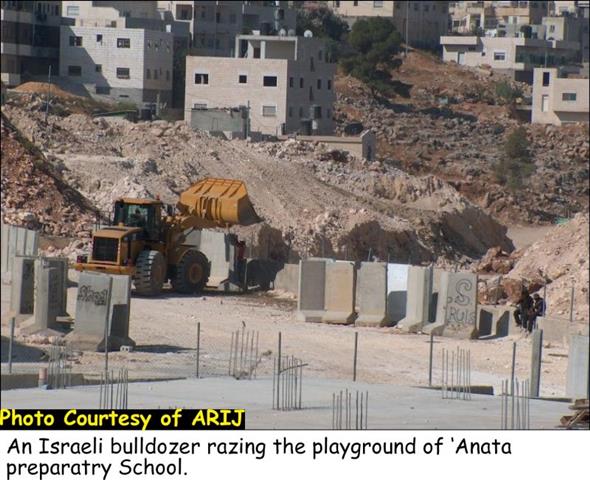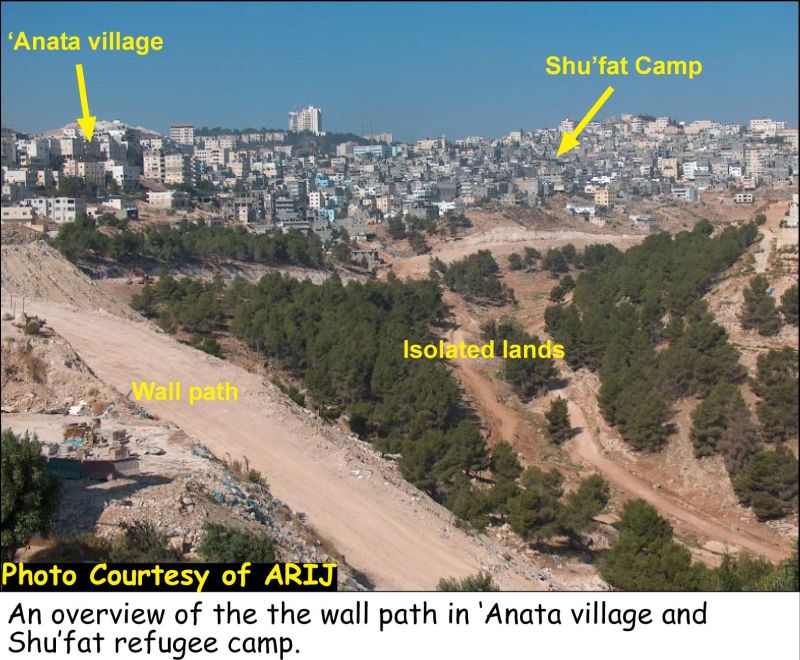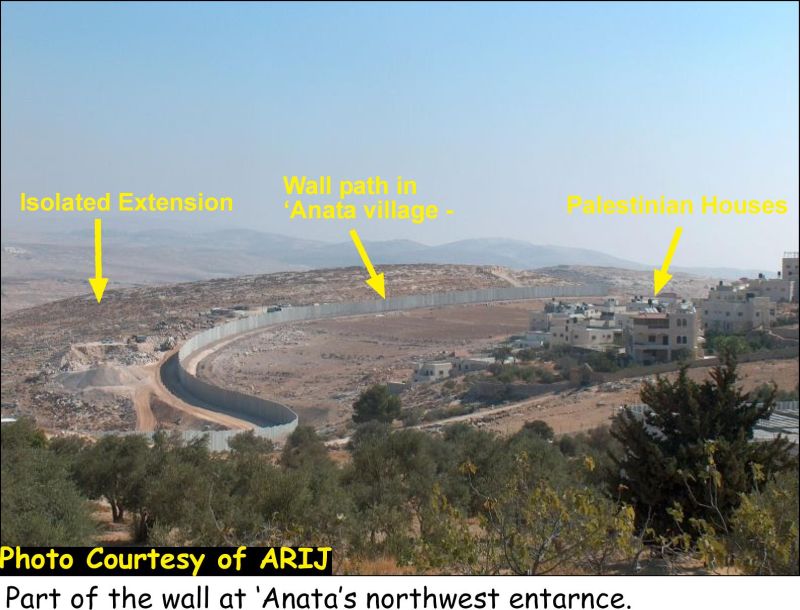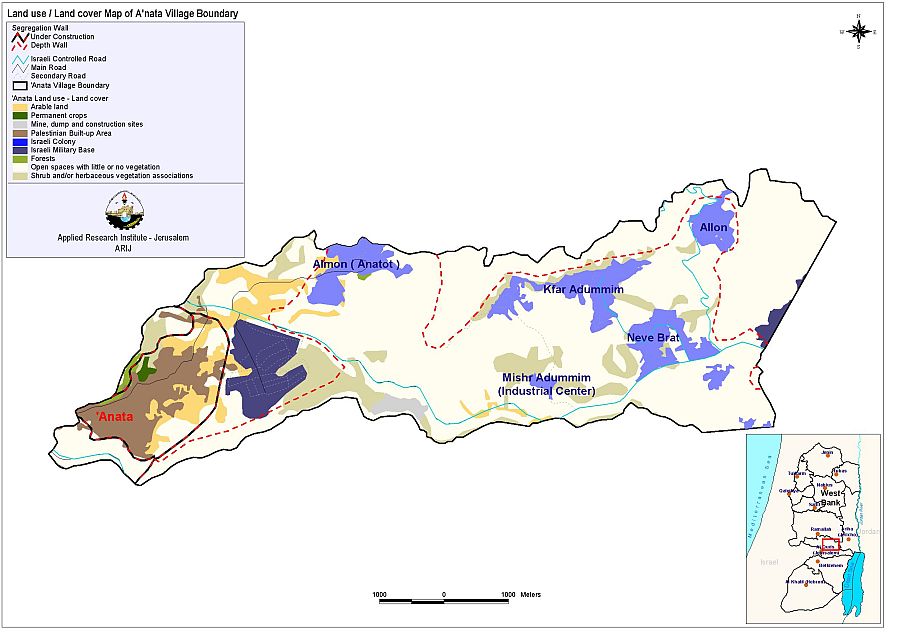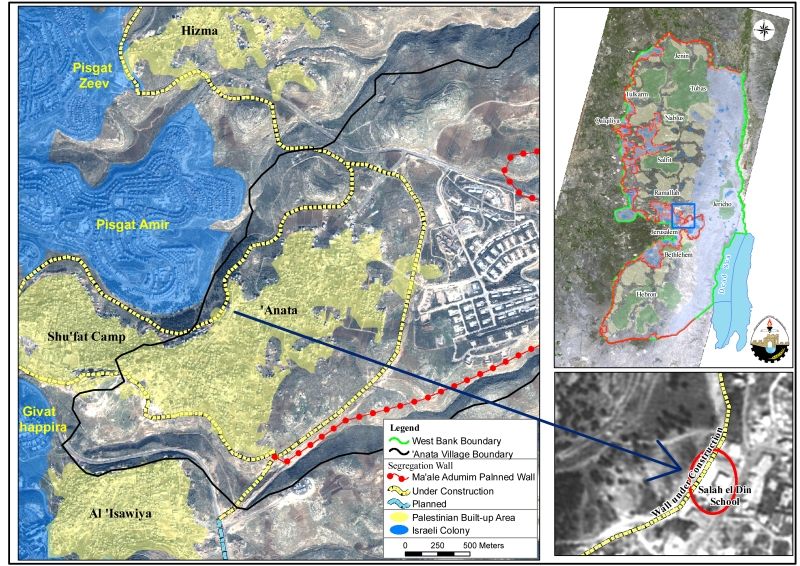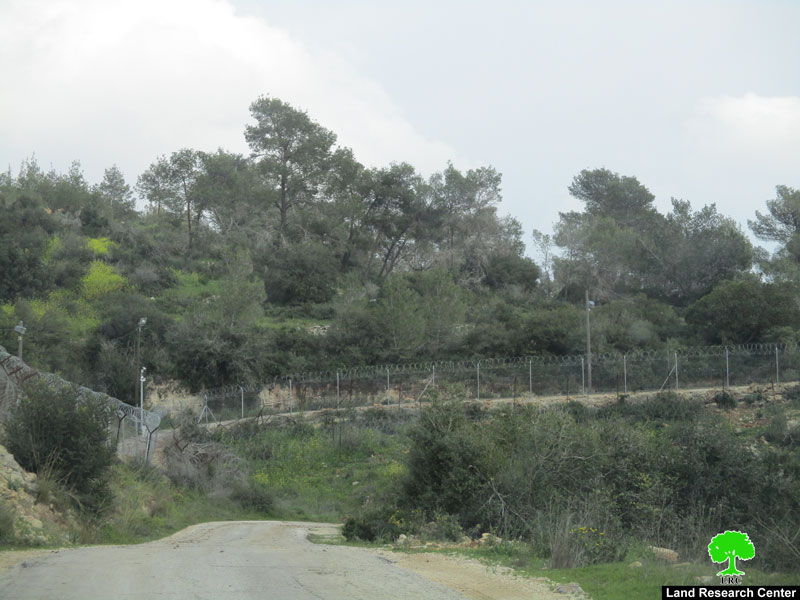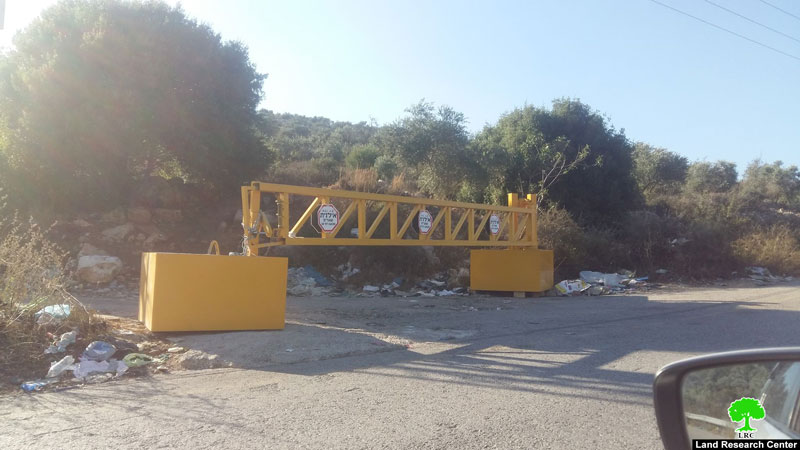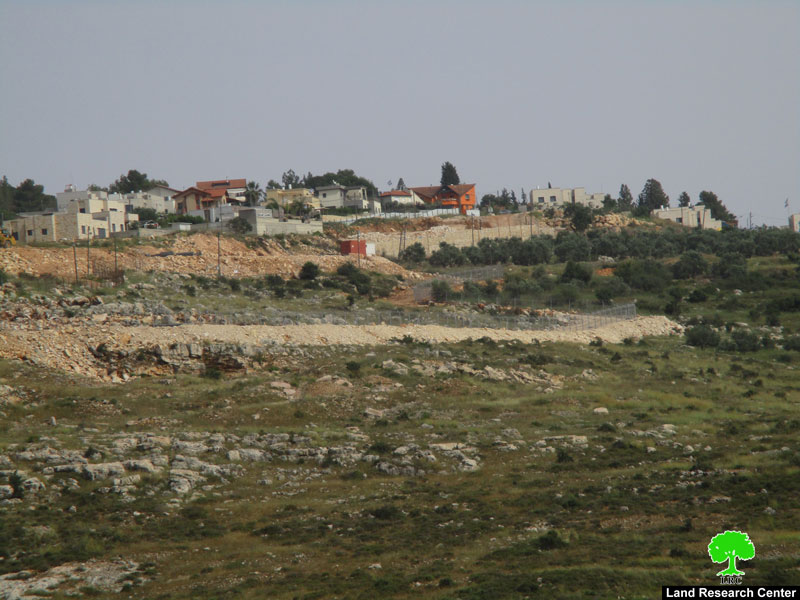The Israeli occupation forces started razing lands in Anata town preparing for the construction of the Segregation Wall. A number of Israeli bulldozers, estimated at 4, staged into the town of 39;Anata in the early morning of August 29, 2005 and demolished the wall of 39;Anata secondary school without any pre-notification. The bulldozers also placed a number of cement blocks in the school yard and continued razing lands guarded by a several Israeli military jeeps which existed in the area.
Today, with the beginning of a new school year, hundreds of students from the nearby Palestinian communities such as Hizma, Ar Ram, Shu39;fat and Shu39;fat Camp who attend school at 39;Anata will start the new school year with a destroyed school yard, an Israeli Segregation Wall and confronting the Israeli soldiers guarding the Wall construction which is cutting through their town causing the isolating of thousands of dunums of the village39;s lands, see Photo 1, Photo 2, & Photo 3
Location
It developed from the Canaanite village of 39;Anatot (Anathoth) named after the Canaanite God of war. 39;Anata has several Archeological sites containing remains of ancient buildings with Mosaic floors. The following hamlets are found in the nearby: Kherbit Ka39;kol in the western part of 39;Anata, Kherbit Deir As Sad located in the eastern part of 39;Anata, Kherbit Al Meet located to the northeast of Anata and Ein Al Fawwar located in the northeastern part of 39;Anata town.
The topography of 39;Anata ranges from mountainous in the west to plain in the east and south. The town occupies an overall area of 30,000 dunums (30 km²), where 21,026 dunums are open spaces. The village is surrounded by Hizma Town from the north, Shu39;fat camp from the west, El Isawiyeh from the southwest and the settlement of Pisgat Amir from the Northwest. See Map 1
Population
The population of 39;Anata village was 285 inhabitants in the year 1922, however, according to the Palestinian State Information Service (SIS), the population continued to grow reaching up to 540 and 954 inhabitants in the years 1945 and 1967, respectively. Today, the village39;s population exceeds 10,000 according to the Palestinian Central Bureau of Statistics 2005 and occupies a built-up area of 1530 dunums (1.53 km²) 5.1% of the village39;s total area.
39;Anata village lands and the Israeli settlements
Today, there are four Israeli settlements established on the western and eastern peripheries of 39;Anata town on lands confiscated from 39;Anata under security claims following the 1967 war. The settlements are:
-
Almon, northeast of 39;Anata town. The settlement was established in 1983 and occupies an area of 792 dunums (0.792 km²).
-
Kfar Adummin, northeast of 39;Anata town. The settlement was established 1979 and occupy an area of 751 dunums (0.751 km km²).
-
Allon, northeast of 39;Anata town. The settlement was established in 1990 and occupies an area of 295 dunums (0.295 km²).
-
Neveh Brat, east of 39;Anata town. The settlement was established in 1992 and occupies an area of 8741 dunums (0.871 km²).
The settlement area inside the village boundary expanded throughout the years to occupy a total area of 2709 dunums (2.709 km²) in 2004 (ARIJ database). In addition to settlements, one military base exists in the eastern part of39;Anata village boundary. The militry base covers an area of 1000 dunums (1km²). See Map 1
Military orders in 39;Anata Village
On March 14, 2004, the Israeli occupation forces served out Palestinian residents of 39;Anata the military order number (22/04/T Judea & Samaria, 2004) stating the confiscation of 46.4 dunums of the village39;s lands to construct the Segregation Wall. On the 27th of the same month, constructions started in the north part of the village and the Israeli Bulldozers razed an area of land very close to a number of Palestinian houses and lies exactly underneath a road used by39;Anata villagers.
On February 20, 2005, the Israeli Ministry of Defense issued an updated Wall plan that included changes mainly in middle and southern West Bank. According to the map, the Wall will stretch for 28 kilometers and will totally encircle 39;Anata and Shu39;fat refugee camp and segregate them in an enclave. The only entrance to the enclave will be from the northeastern entrance of 39;Anata from the Hizma-Anata road. The Segregation Wall will isolate about 21,356 dunums (21 km²) of 39;Anata land that is 70% of the town39;s area. 3503 dumoms will be enclaved, 2780 dunums of which are from Anata town and 724 dumoms from Shu39;fat refugee camp. Approximately 9 kilometers of the wall is under construction and 19km are planned. See Map 2
Problems inflicted by the construction of the Segregation Wall
The residents of 39;Anata and Shu39;ufat refugee camp will be totally isolated in an enclave from the services in the nearby cities of Jerusalem and Ramallah. The enclaved residents will not be able to access the hospitals, schools, universities, employment centers, markets, and other services and facilities.
The enclave is inhabited by a population of about 20,000 people, nearly two thirds of them carry the Jerusalem ID. Residents of Shu39;ufat camp and Dahiyet Assalam in Anata (since they lie within the Jerusalem municipal boundary) pay taxes to the Israeli government including the Arnona tax which is a tax paid for the use of properties including the residential and commercial uses. These residents will continue to pay taxes without getting any services in return.
Additionally, the status of the Palestinian Jerusalemites becomes open to question. As the access to Jerusalem city center will be difficult for them and will be through gates and checkpoints in the Wall which will be controlled by the Israeli occupying forces. Residents will have to go around Qalandyia to reach Jerusalem which would take one and a half hour instead of 20 minutes. The construction of the Wall will hinder Jerusalem from being the39;center of life39; of these enclaved residents, thus make them subject for losing the residency right in Jerusalem.
The Segregation Wall will affect the educational systems in the enclave, as well as the health services, relations between families, the natural territorial expansion and the physiological wellbeing of the people.
Impacts on the educational system
The educational sector is mostly affected by the construction of the Wall due to the large number of schools in the village. The town has three governmental schools and five private ones which accommodate approximately 4500 students and 210 teachers (according to 39;Anata village council). Students and teachers come from39;Anata town and the nearby towns such as Hizma, El Isawiya and Shu39;fat to study and work in 39;Anata schools. The Israeli Segregation Wall will surround 39;Anata from all directions and will adversely affect all those attending and working in 39;Anata schools.
|
Table two: The number of students and schools in A39;nata village. |
|
|
Type |
Students |
|
|
|
|
Privet schools |
|
|
|
|
|
1- Beit Al Maqdis school |
300 |
|
2- Al Iman school |
300 |
|
3-Al Mawakeb school |
600 |
|
4-Shireen school |
400 |
|
5-Nour Al Houda school |
500 |
|
|
|
|
Governmental schools |
|
|
1-Salah Al Din school |
1000 |
|
2-A'nata School for Boys |
650 |
|
3- A'nata School for Girls |
800 |
|
|
|
|
Total |
4550 |
The section of the Wall which is currently under construction is 30 meters away from the school building and in other places, less than 15 meters away from the houses. The Israeli bulldozers already set their equipments inside the school yard where about 1000 students started their first day at school. Students will not have enough space to play during the break or even resume their daily activities at school. This in turn, will cause psychological effects on the students for they will live opposite to a concrete and huge Wall instead of the natural scenes of their lands.
The students will lose their rights and access to proper education which is a right to everyone under the international covenants and human rights. Article 13 of the International Covenant on Economic, Social and Cultural Rights states that the 'They [The States Parties to the present Covenant] agree that education shall be directed to the full development of the human personality and the sense of its dignity, and shall strengthen the respect for human rights and fundamental freedoms. They further agree that education shall enable all persons to participate effectively in a free society, promote understanding, tolerance and friendship among all nations and all racial, ethnic or religious groups, and further the activities of the United Nations for the maintenance of peace.39;.
Conclusion
The construction of the Segregation Wall is a blatant violation of International law, Human Rights and International covenants and Conventions. Among which is article 11 of the International Covenant on Economic, Social and Cultural Rights which states that39; The States Parties to the present Covenant recognize the right of everyone to an adequate standard of living for himself and his family, including adequate food, clothing and housing, and to the continuous improvement of living conditions. The States Parties will take appropriate steps to ensure the realization of this right, recognizing to this effect the essential importance of international co-operation based on free consent.39; The confinement of 39;Anata town and Shu39;fat refugee camp residents and their segregation in an enclave constitutes a major impediment to maintain an adequate standard of living and an acceptable quality of life. This confinement also breaches the freedom of movement which is protected by Article 12 of the International Covenant on Civil and Political Rights (ICCPR) which states: 39;39;Everyone lawfully within the territory of a State shall, within that territory, have the right to liberty of movement and freedom to choose his residence.'
In addition this incarceration constitutes a crime of Apartheid, were 39;apartheid is a crime against humanity and that inhuman acts resulting from the policies and practices of apartheid and similar policies and practices of racial segregation and discrimination, as defined in article II of the Convention, are crimes violating the principles of international law, in particular the purposes and principles of the Charter of the United Nations, and constituting a serious threat to international peace and security.39;
The convention against the crime of Apartheid defined 39;the term the crime of apartheid39;, [as] similar policies and practices of racial segregation and discrimination as practiced in southern Africa, [which] shall apply to the following inhuman acts committed for the purpose of establishing and maintaining domination by one racial group of persons over any other racial group of persons and systematically oppressing them:
(a) Denial to a member or members of a racial group or groups of the right to life and liberty of person
(i) By murder of members of a racial group or groups;
(ii) By the infliction upon the members of a racial group or groups of serious bodily or mental harm, by the infringement of their freedom or dignity, or by subjecting them to torture or to cruel, inhuman or degrading treatment or punishment;
(iii) By arbitrary arrest and illegal imprisonment of the members of a racial group or groups;
(b) Deliberate imposition on a racial group or groups of living conditions calculated to cause its or their physical destruction in whole or in part;
(c) Any legislative measures and other measures calculated to prevent a racial group or groups from participation in the political, social, economic and cultural life of the country and the deliberate creation of conditions preventing the full development of such a group or groups, in particular by denying to members of a racial group or groups basic human rights and freedoms, including the right to work, the right to form recognized trade unions, the right to education, the right to leave and to return to their country, the right to a nationality, the right to freedom of movement and residence, the right to freedom of opinion and expression, and the right to freedom of peaceful assembly and association;
d) Any measures including legislative measures, designed to divide the population along racial lines by the creation of separate reserves and ghettos for the members of a racial group or groups, the prohibition of mixed marriages among members of various racial groups, the expropriation of landed property belonging to a racial group or groups or to members thereof;
(e) Exploitation of the labour of the members of a racial group or groups, in particular by submitting them to forced labour;
(f) Persecution of organizations and persons, by depriving them of fundamental rights and freedoms, because they oppose apartheid, Article II of the International Convention on the Suppression and Punishment of the Crime of Apartheid.
Prepared By
The Applied Research Institute – Jerusalem
ARIJ

